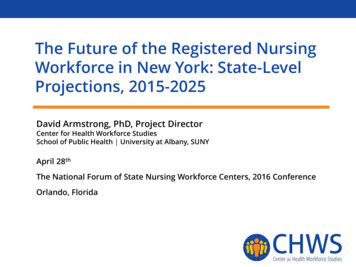
Transcription
The Future of the Registered NursingWorkforce in New York: State-LevelProjections, 2015-2025David Armstrong, PhD, Project DirectorCenter for Health Workforce StudiesSchool of Public Health University at Albany, SUNYApril 28thThe National Forum of State Nursing Workforce Centers, 2016 ConferenceOrlando, Florida
Background HRSA’s Health Workforce Simulation Model The Future of the Nursing Workforce: National- andState-Level Projections 2012-2025 HRSA’s Web-Based Nursing Modelhttp://chws.albany.edu2
The Future of the Nursing Workforce Report presents findings for the “status quo” model Assumes supply and demand are in equilibrium The national supply of both RNs and LPNs willsurpass demand by 2025o RN and LPN supply are expected to grow by more than950,000 FTEs and 260,000 FTEs respectivelyo RN and LPN demand is expected to grow by more than610,000 and 200,000 respectively Distributional imbalances exists across stateshttp://chws.albany.edu3
HRSA’s Web-based Nursing Model The web-based model will allow researchers to createtheir own scenarios using a variety of leverso Entry of BSNs, ADNs, and LPNso Retirement ageo Hours per week worked Available to general public ws.albany.edu4
HRSA’s Web-based Nursing Modelhttp://chws.albany.edu5
HRSA’s Web-based Nursing Modelhttp://chws.albany.edu6
HRSA’s Web-based Nursing Modelhttp://chws.albany.edu7
Use Your Own Data The web-based model also allows you to use your owndata The present study uses RN data from the New YorkLicensure Re-registration Surveyhttp://chws.albany.edu8
Overview of New York Study Compare the “status quo” model using theprepopulated data to the “status quo” model usingNY RN data Demand for RNs in New York 2 Scenarioshttp://chws.albany.edu9
The Status Quo Model Suggests SlowerGrowth When Using the NY RN Datahttp://chws.albany.edu10
There Were Fewer Jobs for New Graduatesin 2014 Compared to 2006 in New Yorkhttp://chws.albany.edu11
The Supply of RNs Exceeds Demandin New Yorkhttp://chws.albany.edu12
2 Scenarios Increase and Decrease entrants by 10% annually Early and Delayed Retirement (2 years)http://chws.albany.edu13
Graduation Scenarioshttp://chws.albany.edu14
Retirement Scenarioshttp://chws.albany.edu15
Conclusion HRSA’s new web-based nursing model is a powerfulnew tool that allows researchers and policy makersto model change Your data can make a difference The projections are sensitive to changehttp://chws.albany.edu16
David Armstrong, PhD, Project Director Center for Health Workforce Studies School of Public Health University at Albany, SUNY April 28th The National Forum of State Nursing Workforce Centers, 2016 Conference Orlando, Florida The Future of the Registered Nursing Workforce in New York: State-Level Projections, 2015-2025










